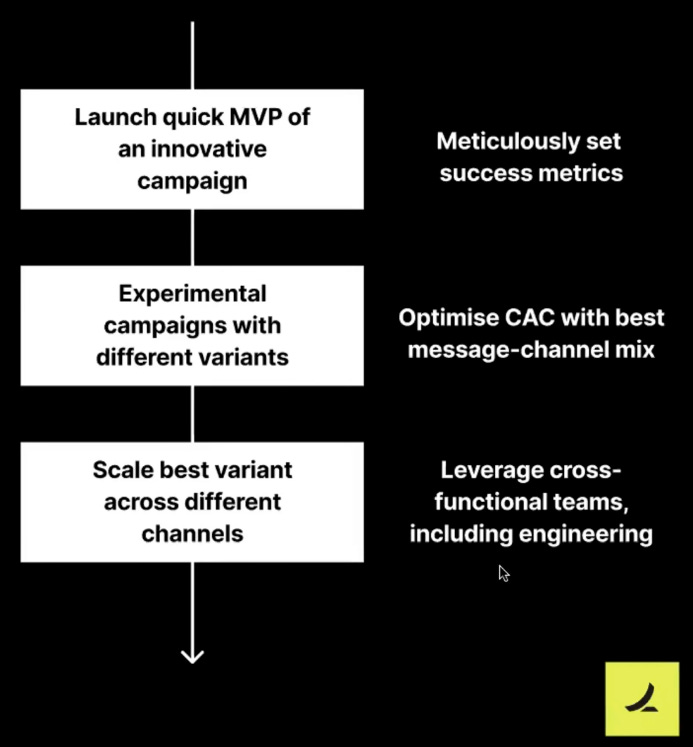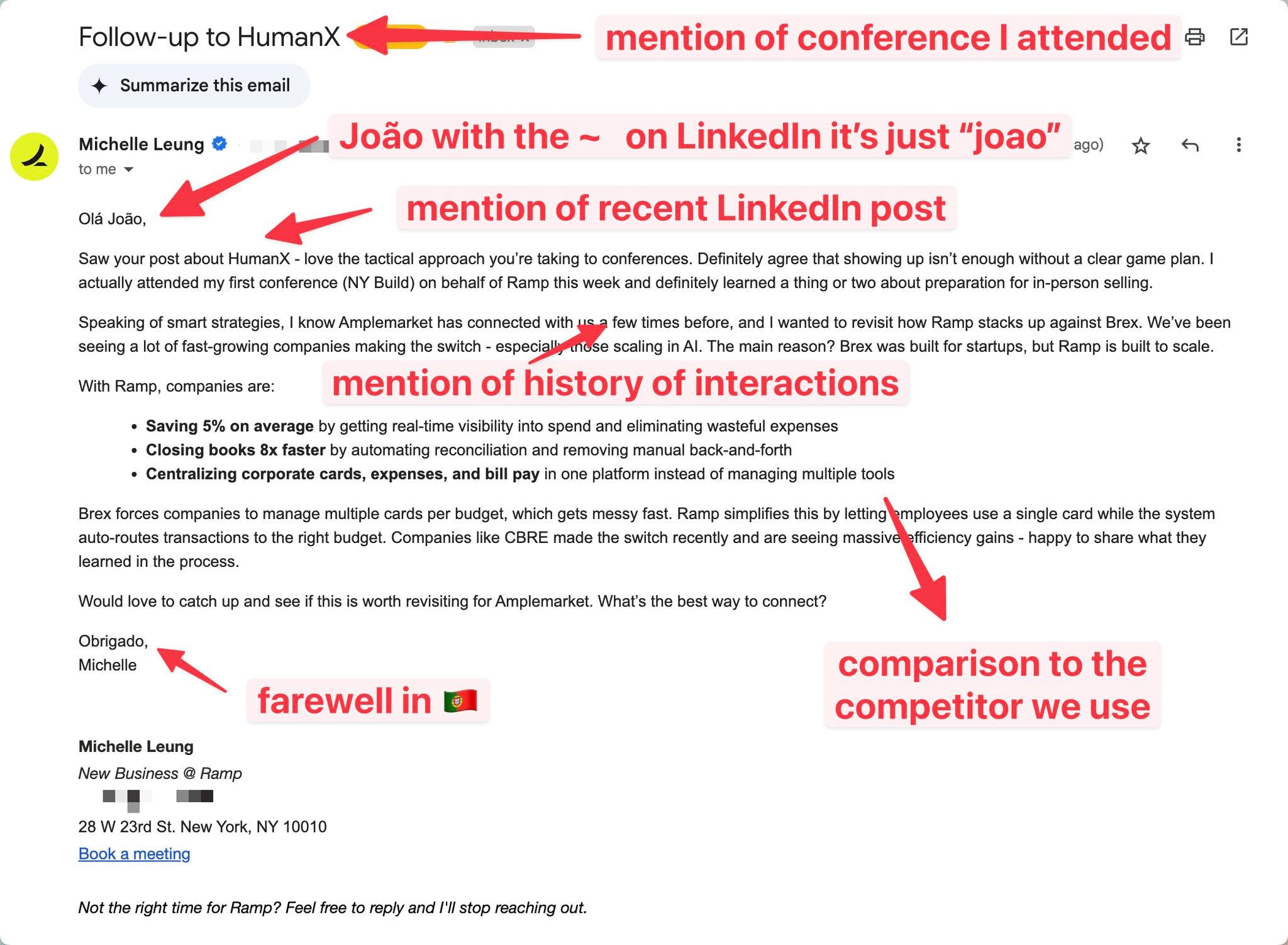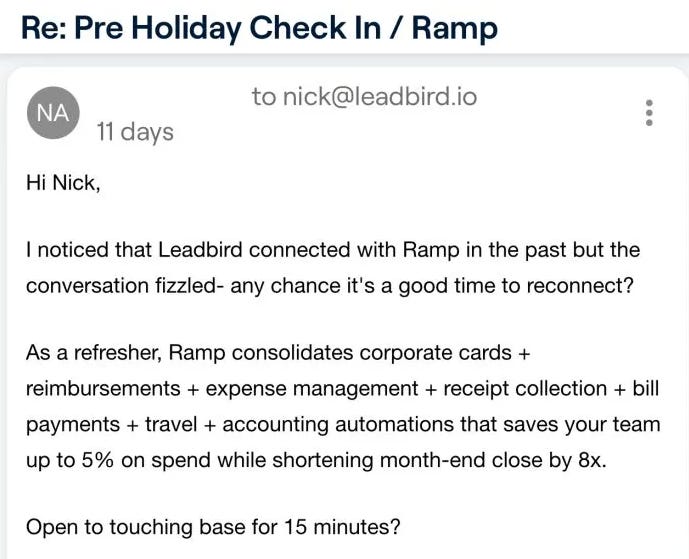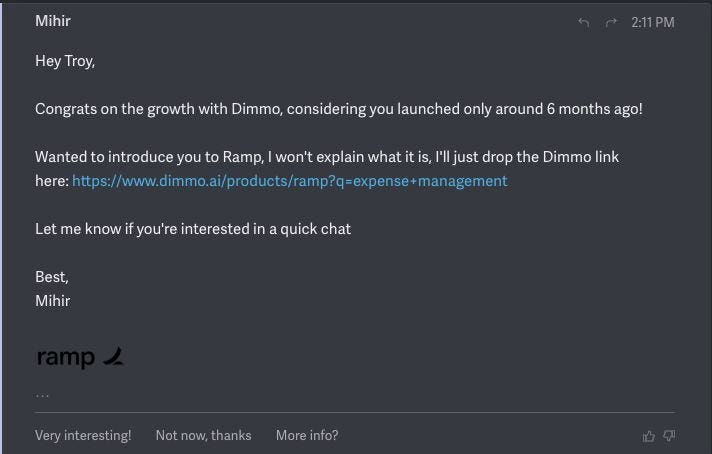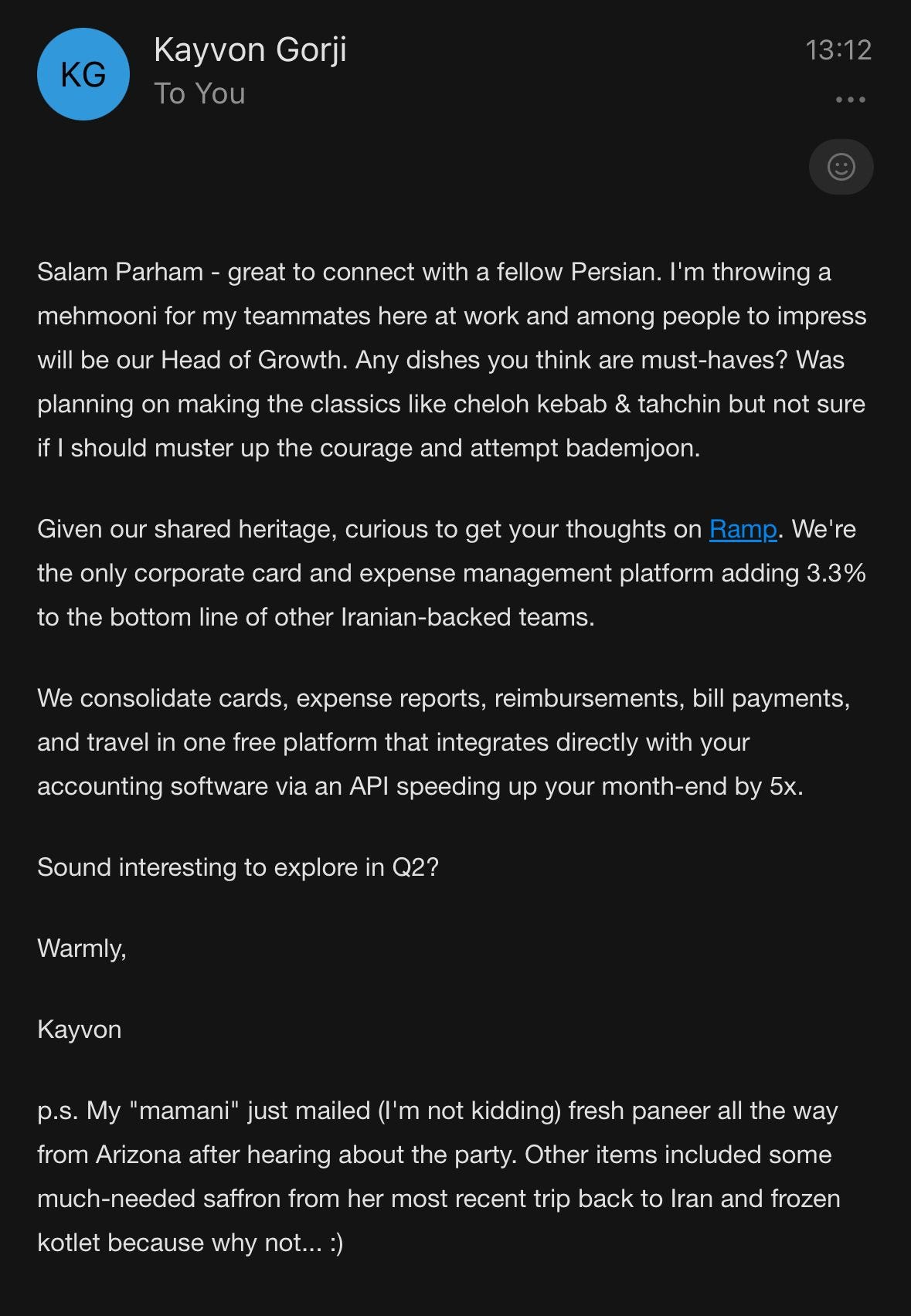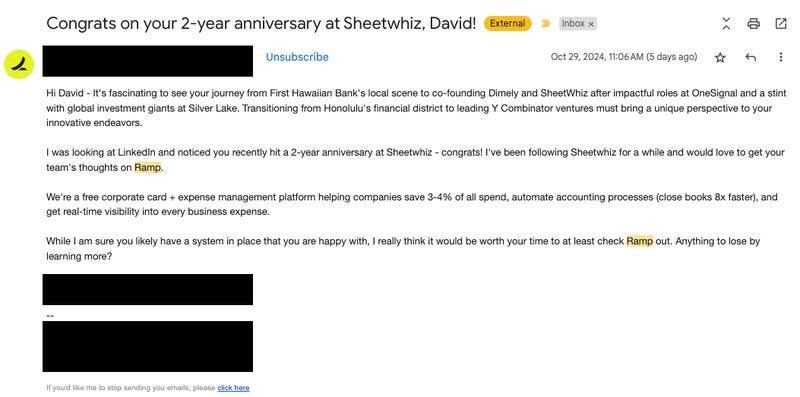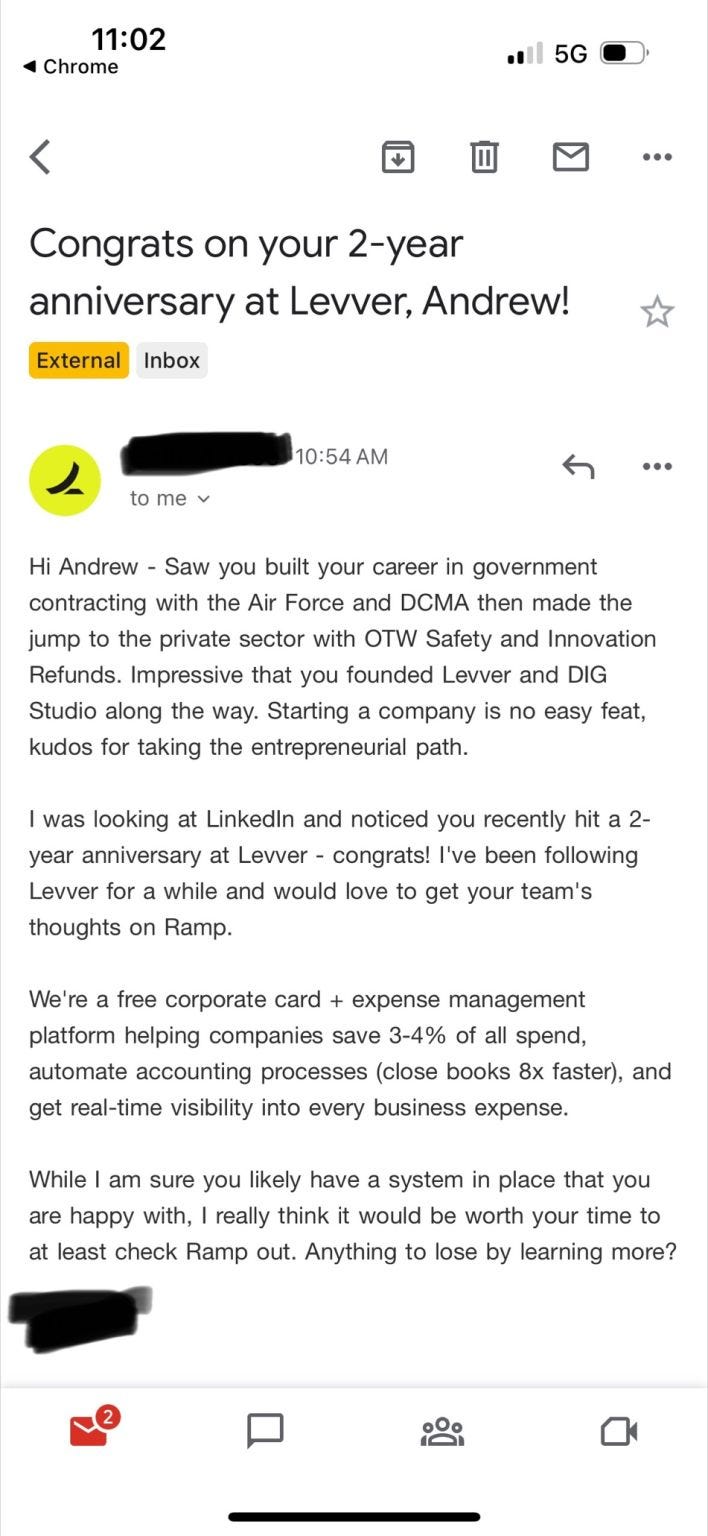How Ramp Scaled to $1B ARR With Outbound
6 Outbound Differentiators + 8 Cold Emails
Read time: 20 min
👋 Hey, Elric here! Welcome to this week’s free edition of Outbound Kitchen. Every week, I break down real questions about scaling outbound so you can turn it into your #1 growth engine. Thinking about upgrading to the paid newsletter? Here’s what you’ll get:
Instant access to 16 paid newsletters, including:
My Outbound Chef Kit: 100+ resources (email templates, cold call scripts, AI prompts, top outbound tools, and more, everything the best outbound teams use. Worth $1,000+)
The subscription costs $178/year (or $22/month). And the best part? You can try it free for 7 days. Cancel anytime.
But I think you'll love it!
👉 Start your free trial today.
In 2019, Ramp was just another fintech startup in a crowded market.
By 2025:
$1B ARR
$13B valuation
#1 growth engine: Outbound
Named:
the best-run private company on the planet.
By legendary investor Keith Rabois.
But Ramp didn’t scale by brute force.
They built a Michelin-grade outbound machine:
40,000+ SQLs generated
Grew to 130+ SDRs and 400+ sales reps
Outbound system forecasts 75% of future SQLs
The average SDR at Ramp books 3-4x as many meetings as their next closest competitor. — Eric Glyman, CEO Ramp
I spent 20+ hours dissecting Ramp’s outbound machine, podcasts, articles, LinkedIn posts, and distilled their playbook into 6 key differentiators.
You’ll learn exactly:
6 things Ramp does differently with outbound
8 cold emails that actually booked meetings (5 Human, 3 AI) with a 10% reply rate
Their outbound and data tech stack
Actionable insights to implement based on your stage: < 10 Reps, 10 to 50 Reps, and 50+ Reps.
Let's get cooking!
1. Ramp at a Glance
Why this matters: it sets the bar for what a Michelin-grade outbound engine can achieve.
📈 Snapshot
ARR: $1B (hit in Sept 2025)
Valuation: $13 B (Mar 2025 secondary sale)
Capital Raised: ~$2 B to date
Buyers Personas: Finance leaders & business owners
Competitive Focus: Ramp vs. Amex (Not Brex)
Ramp isn’t battling other fintechs like Brex.
They’re taking on giants like American Express.
Inside Ramp’s Explosive GTM Growth
Sales team jumped from 130 → 400+ reps in just (2022 → 2025).
SDR team grew from 1 → 130 SDRs over 5 years.
Pipeline Machine: 40,000+ SQLs Generated
Ramp built an elite pipeline-generation machine:
170+ new SDR hires and 80+ internal promotions.
40,000+ SQLs generated (ACV ~$35k, RepVue).
Estimation of: $1.4 billion pipeline → ~10% close rate → $140M ARR sourced just by the SDRs team.
Ramp built one of the highest-performing outbound teams in SaaS.
They combined talent development, high-efficiency processes, and a relentless focus on productivity.
Next up:
Ramp’s exact strategies, tech, talent, and AI-driven outbound systems, so you can implement their outbound differentiators today.
2. The Ramp Difference: 6 Outbound Differentiators
Quick answer?
It’s the mix of speed-first mindset, a strong growth team, tiger teams for testing, a solid data team, how they use AI and tools, and their sales culture.
2.1 Velocity Culture: Ship Fast, Learn Faster
They count the days because every extra day costs pipeline.
Why Speed is Non-Negotiable for Ramp
CAC isn’t linear, it compounds, every delay multiplies your costs.
Ramp runs at least 200 experiments per quarter to out-learn the market.
Short feedback loops mean weekly upgrades, not quarterly stagnation.
How Ramp Builds Velocity into Outbound & GTM
Day-Counter North Star: days.ramp.com flashes Ramp's age company-wide. Constant reminder that tomorrow is already too late.
Two-Day MVP Rule (even for the GTM team): If an idea can’t launch in 48 hrs, it’s reduced or killed. Weekly experiments, not quarterly delays.
Impact × Confidence Tracker: They use Airtable to track experiments; losers die at Friday retro. Resources are laser-focused on proven wins.
How you can implement that
1. Drop CAC/LTV for 90-Day SQL Pipeline and Payback
Forces Growth, Marketing, Ops, & SDRs into high-efficiency, revenue-generating alignment.
2. One Shared OKR:
Example: “Increase pipeline per rep by 10% weekly.”
Ends finger-pointing and boosts cross-team accountability.
3. Ship One Weekly Experiment (Non-negotiable):
Small ideas count (e.g., cold email opener, direct-mail trigger, AI tweak).
30-minute Friday retro: scale what works, cut the noise.
4. Adopt the 48-Hour Rule:
Can’t launch in 2 days? Cut scope until it can.
Iterative speed trumps perfect slowness every single time.
5. Make Urgency Visible:
Create your own countdown (“Days Since Founding”)
Visual reminders beat static slides every time.
Set the tempo right, and your outbound engine compounds weekly, not quarterly.
2.2 Growth Team (And Engineers)
Fast-growing companies like Ramp (or Pigment) have something powerful in common:
Dedicated growth teams outside of traditional marketing.
Product, data, and engineering resources solely focused on outbound, and pipeline efficiency.
2.2.1 What Does Ramp’s Growth Team Actually Do?
Ramp’s Growth Team operates like a mini-product team focused on a single KPI: SQL Pipeline (customer acquisition).
Here’s their recipe:
200+ experiments per quarter in tight, two-week sprints.
Heavy investment in contact data (80–90% TAM coverage).
Engineers dedicated exclusively to sales and outbound efficiency.
Rapid MVP builds, experiments launch quickly, learnings compound into ARR.
Measured on SQL pipeline and payback, because it delivers a faster feedback loop than LTV/CAC.
Invest in a strong GTM stack: to be different than competitors → Competitive advantage.
Use a growth mindset: Experiment velocity beats perfect planning; most tests should fail, but each creates learning compounding into ARR.
How do they run experiments?
Ideate → Do it manually and build an MVP → Test and learn → Scale
They balance qualitative with quantitative: Ramp’s experimentation culture permeates every team but not every team tracks experiments in the same way. The growth team tracks everything in Airtable and is very quantitative. Their pipe gen experiment results tend to be more black or white.
Guillaume Cabane shared this in the video: Winning through multi-channel, multi-person outreach.
3 Example Experiments they run:
#1 Direct Mail API ($1/Postcard)
What: Auto-send personalized postcards to high-intent leads.
Why: Low CAC
#2 SDR Call Blitz
What: One SDR tested dialing 1800 calls in one day using Orum.
Why: Push limits to uncover efficiency hacks other teams miss.
#3 AI-Powered Email Triage
Problem: Reps overwhelmed by email replies, performance suffered.
Ramp’s Solution: Built an internal Gmail overlay using AI to:
Classify & prioritize emails instantly.
Surface key data points and stack hottest leads on top.
Result: Reps doubled email throughput.
Implement this tactic (if your reps get too many emails):
Start with a Zapier + OpenAI classifier that tags inbound replies hot / warm / not interested.
Auto‑append enrichment (Clearbit → HubSpot custom fields).
Measure emails‑replied‑per‑hour as your north‑star efficiency metric.
2.2.2 How Ramp Tiers Their Outbound Funnel
Ramp segments outreach by account value, cost, and LTV. Here’s their funnel:
Main Funnel:
Tier 1 (Highest): Handled manually by SDRs. Sent via Gmail (best reply rates).
Tier 2 (Virtual SDR): AI-generated, personalized emails sent from Gmail. (44% better replies vs tools like Outreach)
Tier 3 (Automated): Same messaging, high-volume playbook via Outreach.
Second Funnel (Growth Team exclusive):
Completely independent infrastructure (domains, IPs, data sources).
Different buying signals, tech stacks, and playbooks.
Guillaume Cabane shared this in the video: Winning through multi-channel, multi-person outreach.
Why a Second Funnel?
Outbound is Ramp’s #1 channel, they never put all eggs in one basket.
A competitive internal benchmark, always optimizing, always improving.
Implement Ramp’s Playbook (Today)
Set one pipeline KPI: SQL pipeline.
Test relentlessly: Aim for rapid, iterative learning.
Engineer efficiency: Invest in automation & engineering support for sales.
Create redundancy: Multiple funnels & playbooks to maximize pipeline and hedge risks.
2.3 Ramp’s Tiger Teams: Rapid Testing, Zero Disruption
On top of the growth team.
They also run Tiger Teams: small, dedicated squads (with SDRs or AEs) that rapidly test new tools, data, or outbound strategies without disrupting the main funnel.
They didn't share exactly how they run this, but here's an example of how you can run a Tiger Team:
Small, cross-functional team
Single clear hypothesis (e.g., “Test a new tool, measure efficiency vs the main funnel”).
Rapid execution: Max 4-week sprints
Clean measurement: Clear attribution (separate Salesforce tags & sequences) to avoid polluting core metrics.
You can start a Tiger Team this week:
Identify one outbound bottleneck each month (email reply speed, data freshness, call connect rates, etc.).
Nominate a dedicated 4-person Tiger Team: (1 Growth PM, 1 SDR, 1 Data, 1 Eng).
Protect their calendar and resources to ensure velocity.
Test rapidly (2–4 weeks) with clear attribution vs baseline.
Run a “Promotion or Kill” retro: → Only ~25% of experiments should join the main playbook.
2.4 Advanced Data Stack & Automation
Another thing they do differently: their modern data stack.
Similar to top teams at Snowflake, Pigment, Rippling, and Owner.com.
1. Snowflake: Instant Access to All GTM Signals
What Snowflake Does:
Centralizes all GTM data, enabling fast queries and instant data access.
Think of it as the central kitchen where every piece of data gets processed before it’s served to sales, marketing, or ops.
Before Snowflake:
Slow, crashing dashboards due to query overload
Data delays, mistrust among reps
With Snowflake:
Instant scaling & rapid data updates
Real-time signals for GTM teams, no waiting on engineers
Why it matters for GTM:
Instant freshness, reps move immediately on signals
Eliminates friction between data teams and outbound execution
2. Hightouch: Data Activation & Personalization
What it is:
Hightouch is a reverse ETL tool, it takes clean data from your warehouse (like Snowflake) and syncs it into tools like Salesforce, HubSpot, and Outreach.
Before Hightouch:
Ramp’s data team had to build Python scripts to manually push data into CRMs.
Campaign personalization was clunky or nonexistent.
With Hightouch:
Automatic enrichment of CRM fields (product usage, churn risk)
Personalized campaigns triggered by real behaviors (feature activation, payment gaps)
➡️ Why it matters for GTM:
Scales personalization
Enriched insights empower SDRs
3. GTM Experimentation at Ramp Speed
With their data stack (dbt + Snowflake + Hightouch), Ramp:
Launches outbound campaigns from fresh signals in <24 hours
Tests new segmentation, copy variations, and channels rapidly
Instantly responds to real-time usage or billing events
🎯 Why Rapid Experimentation Matters:
Agility creates a competitive moat
Move faster than competitors
2.5 Ramp’s GTM: 11 AI Use Cases
Why Ramp’s GTM Team Uses AI
AI isn’t a rep replacement: It automates tedious tasks so reps build better relationships.
Scale without breaking: Eliminates repetitive manual work that would slow down hypergrowth.
Increases efficiency: Automates lead management, data cleaning, and admin work so reps focus on closing.
Ramp picks AI solutions carefully
Built a financial model to decide “build vs. buy.”
Chose third-party tools where it saved time and resources.
Focused their engineers on customizing and enhancing third-party solutions instead of reinventing the wheel.
Ramp’s 11 AI GTM Use Cases
1 - Autofill CRM Fields: (MEDDPICC)
Tool: Momentum AI
Automatically fills critical fields in Salesforce.
Reps override only if necessary—clean data without manual entry.
2 - Why Deals Actually Close or Fail
AI captures nuanced deal context—beyond simple “reason lost” fields.
Uncovers precise deal-breakers (product gaps, timing, competitors).
Transforms messy notes into structured, actionable insights.
Before vs After: Replace useless pie charts with meaningful insights.
3 - Real-Time Deal Risk Alerts
AI flags disengaged prospects immediately.
Managers get instant Slack alerts to intervene early.
Prevents deals from slipping silently away.
“Instead of waiting for a post-mortem, we step in immediately.”
4 - Instant Product Answers (Slackbot)
Slackbot answers product questions instantly during sales calls.
Removes delay, no more “let me get back to you.”
💬 Example:
Prospect asks if a feature exists → Slackbot instantly provides details & resources.
5 - AI-Enhanced Cold Emails (Without Losing Human Touch)
AI scores leads, prioritizes replies, and categorizes intent.
SDRs use AI suggestions but retain human oversight.
Email efficiency skyrockets without robotic outreach.
6 - Outbound Scoring (Actively AI)
Analyzes past emails, deals, and external signals.
Predicts prospect intent and improves lead prioritization continuously.
Learns and refines scoring models automatically.
7 - Seamless AE to CSM Handoff (Tool: Momentum)
AI generates detailed onboarding dossiers (MEDDPICC, calls, commitments).
Automatically syncs context into Slack/Salesforce, no manual digging.
Smooth handoff reduces friction and accelerates onboarding.
8 - Smooth SDR to AE Handoff (Tool: Momentum)
Share real-time context via Slack DM.
AE & SDR aligned instantly, no lost info or back-and-forth emails.
Convert deals to SQL with a click in Slack.
9 - Auto-Identify International Coverage
AI detects if prospects operate internationally without rep input.
Eliminates manual, inaccurate data entry.
Ensures reps only input relevant and accurate data.
Impact: Accurate targeting, no wasted seller time.
10- Visualize Accounts (Tool: Rox)
Modern CRM visualization—intuitive, customizable, AI-enhanced.
Natural language search turns data rows into actionable insights instantly.
Benefit: Simplified rep experience → quicker pipeline insights.
11 - Real-Time Sales Performance Tracking (Tool: Atrium)
Detects subtle sales process changes early.
Highlights patterns, anomalies (meetings booked, response rates).
AI surfaces critical insights that teams often miss.
Example: Quickly spot why meetings booked suddenly drop.
Implement Ramp’s AI Playbook (Today)
Use AI strategically, build vs. buy intentionally.
Automate tedious tasks, not relationships.
Focus your engineers on customizing, not reinventing tools.
Keep humans in control, but empowered by AI-enhanced insights.
AI isn’t magic. It’s leverage that makes your GTM team smarter, faster, and scalable.
2.6 Ramp’s Sales Culture
SDR KPIs
Ramp doesn’t set activity quotas (calls/emails):
No minimum dials or emails per day.
Instead, SDRs own their outcomes, results over activities.
Example: One SDR dialed 1,800 calls in a single day with Orum to test cold calling limits.
Compensation Plan: Quality AND Quantity
Ramp evolved their SDR compensation to balance quantity and quality:
Initially: Only rewarded meetings booked → lots of noise, poor quality.
Now: SDR comp tied to both:
SQLs generated
Closed-won deals (or advanced stages for enterprise deals).
Max Freeman, VP of sales:
“If I could redo one thing from day one, I’d tie SDR comp directly to quality, SQLs and revenue outcomes, not just meetings booked.”
Radical Transparency in Outbound
Ramp uses a dedicated Slack channel (#outbound-meetings) to broadcast SDR wins:
Every meeting booked is publicly shared:
Prospect details
Exact outreach method that worked
Instant visibility drives accountability and replicable success.
Hiring for “Figure-It-Out” Mindset
Ramp prioritizes resourcefulness over resumes:
Avoids: Big-brand sales veterans overly reliant on brand recognition.
Values: Candidates with intelligence, hustle, and ambiguity tolerance.
Actively hires ex-finance talent (Goldman Sachs, Citi) for analytical rigor.
Looks for generalists who thrive in uncertainty, people who “figure it out.”
✅ Ramp’s Hiring Checklist:
Analytical horsepower (finance background)
Ambiguity-friendly mindset
Proven self-starter, not dependent on brand
Implement Ramp’s Culture & Hiring Playbook
Measure SDRs by quality and revenue, not just activity.
Reward behaviors that directly impact pipeline and revenue.
Implement radical transparency: show everyone what’s working (and what’s not) with outbound.
Hire for resourcefulness and analytical rigor over big-brand experience.
3. 8 Cold Emails That Actually Booked Meetings (5 Human, 3 AI)
Ramp doesn’t just preach personalization or automation.
They mix both.
Here’s a breakdown of 8 real outbound emails, crafted by humans and AI, that actually worked.
3.1 Human-Crafted Emails
Email 1
By: Nico Baila, Senior, New business at ramp
Why it worked:
Used the viral subject line “found you on the internet” to reference the prospect’s own post.
Played into ego: mentioned follower count, post engagement, etc.
Tight structure: ~100 words, 4 simple paragraphs.
Humor + timing = booked meeting.
Email 2 - Straight to Amplemarket CEO
By: Michelle Leung, SDR at Ramp
To: João Batalha, Co-Founder and CEO at Amplemarket
Why it worked:
Subject line + opening referenced prospect’s own LinkedIn posts.
Tied sender’s conference attendance (NY Build) to prospect’s industry.
Recalled a prior conversation for context.
Greeted the prospect in Portuguese 🇵🇹 → nailed cultural touch.
Ended with a direct CTA: “Let’s reconnect.”
Email 3 - Closest Lost Opp Re-Engagement
Direct follow-up to a lost opportunity.
Email 4 - Straight to Dimmo's CEO
Dimmo is a platform to evaluate software on your own (no demo needed)
So the rep used that in the email.
Email 5 - Community Engagement
Target: Finance execs from the Persian community
Why it worked:
Cultural inside joke + friendly tone.
Only works in specific markets (US), not Europe.
3.2 AI-crafted examples
Email 6 - NCAA Games + Finance = Cold Outreach Gold
AI detected college attended → linked to upcoming game.
Integrated personalized betting predictions (built internally).
Used that hook to start convos around switching cards/tools.
Reply Rate: >10%
Why do they use that?
Because they have low intent signals on people changing credit/spending cards. So they use the best personalized/relevant way to start a conversation.
Subject: Syracuse v. Clemson (William & Mark intro) William Genesen
Hi Mark, I have a quick wager that I want to propose to you. You get a million cold emails a month and I send a million cold emails a month so let's try to add some spice here.
As I'm sure you are well aware, Syracuse & Clemson play on Oct 22nd. If Clemson beats Syracuse, you give me 20 minutes of your time to tell you about how Ramp can help you and the team over at C+C. If Syracuse wins, your next lunch is on me!
If you're unfamiliar with Ramp, we're the fastest growing corporate card and expense management business in the US - having raised over $1.5B in the past 2 years from the likes of Goldman Sachs, Citi, Stripe, Founders Fund, and more.
Our free platform consolidates your entire financial stack enabling you to cut wasteful spending, close the books 8x faster (automatic receipt capture, automated transaction coding & a whole lot more), and put 3-4% of your spend back in your bank account.
What do you think? Anything to lose by giving us a look?
Looking forward to hearing from you,
WilliamEmail 7 - Work Anniversary Trigger
“soft” intent signals open doors.
Email 8 - Work Anniversary Trigger
Even basic signals (like work anniversaries) can turn into high-context intros with finance leaders.
4. Ramp’s Composable Outbound Stack (2025)
Built for Speed, Precision, and Scale
Why They Built a Composable Stack
Ramp designed their GTM engine around one principle:
Velocity beats complexity.
Moving beyond 1 signal → 1 sequence.
Adopting ML models to decide the next best action—not just the next email.
A composable stack = fast iteration, clear ownership, less vendor lock-in.
Guillaume Cabane shared this process in the video: Winning through multi-channel, multi-person outreach.
Tech Stack Maximized for Performance
Ramp runs multiple layers of infrastructure to stay one step ahead.
IP Identification: 3 vendors
Contact Data Stack: Waterfall setup via Waterfall.io + in-house waterfall = 5 vendors layered.
Scoring Engine:
ML model forecasts company value.
Routes accounts based on potential ARR, ICP fit, and timing.
Output Channels (based on tier):
Physical goods (direct mail)
Phone
Chat + personalized email
Web content or ad exposure
Ramp’s Sales Tech Stack
Result:
They forecast 75% of all future SQLs in their database before the rep ever reaches out.
40,000+ SQLs generated
Grew to 130+ SDRs and 400+ sales reps
5. How to Implement This for Your Business Based on Your Stage
Below we translate Ramp’s 6 differentiators into stage-specific actions.
5.1 Stage 1 < 10 Reps
Unit economics first. Nail the math on one rep, then scale the head-count.
North-Star Mindset
Adopt Ramp’s “days since founding” counter. A public clock forces everyone to ship daily, not someday. 
Replace CAC :LTV with a 90-day “SQL pipeline and payback” target. It’s a faster feedback loop and keeps founders close to revenue.
Actions You Can Ship This Month
1 - Hire one GTM engineer (not a full growth team).
Their charter: automate prospect list building, instrument basic dashboards, stand up enrichment workflows.
2 - Adopt the 48-Hour MVP Rule.
Every new outbound idea (email hook, call opener, direct-mail test) ships inside two days, no slides, just do it.
Friday 30-minute retro: keep winners, kill losers.
3 - Manual-First Growth Hacks.
Send the first 100 cold emails from Gmail, log every reply in a Google Sheet, tag by persona/problem.
When inbox volume hurts, bolt on a Zapier + OpenAI classifier to triage “hot / warm / not interested.”
4 - Data Coverage.
Spend a few hundred dollars on an Apollo → Clay waterfall to reach 80 %+ of your TAM.
Track bounce and match rates weekly; stop guessing about list quality.
5 - Step Outcome-Based SDR Comp (Day 1).
Pay on SQLs accepted and a small kicker for closed-won; never on dials or emails sent.
Result: you’ll spot the repeatable play before you burn cash on tooling or headcount.
5.2 Stage 2 – 10 to 50 reps
Introduce leverage: data, light engineering, and a mini P&L for pipeline.
Operational Layer
Stand up a micro growth pod: 1 GTM engineer + 1 data analyst + the outbound manager. Their single metric: pipeline per rep.
Spin up a “second funnel” on separate domains/IPs. It’s your in-house A/B lab that never pollutes the main brand, exactly how Ramp benchmarks new tactics.
Stand-Up a Micro Growth Pod.
They run two-week sprints and log every test in Airtable, exactly like Ramp’s 200-experiment rhythm.
Launch Your First Tiger Team.
Four people, four weeks, one hypothesis (e.g., power-dialer or direct-mail API).
Give them separate Salesforce Campaign tags so core metrics stay clean.
Split the Funnel.
Tier 1: high-value accounts, manual emails from Gmail.
Tier 2: AI-written but human-edited emails, still from Gmail (Ramp sees 44 % lift vs sequencers).
Tier 3: automated sequences in Outreach/Salesloft for the long tail.
Introduce Radical Transparency.
A public Slack channel posts every booked meeting: prospect, medium, snippet of the message.
Reps copy what works; managers coach on real data.
Iterate Comp for Quality.
Move to 70 % SQLs, 30 % revenue influence.
This nixes the “book-and-dump” behavior Ramp fought early on.
First AI Assistants.
Email-reply triage (Zapier + OpenAI).
Basic outbound scoring (Actively-style) using historical win fields—start simple, CSV + Python is fine.
Result:
pipeline per rep climbs while admin friction falls; you’re now ready for industrial-grade scale.
5.3 Stage 3 – 50 + reps
At this size, your growth formula is a system, engineers and analysts belong on the frontline.
System Architecture
Evolve the lone GTM engineer into a full growth engineering squad that owns the outbound stack end-to-end.
Move from “1 signal → 1 sequence” to ML-driven “next-best-action.” Ramp’s model now predicts 75 % of future SQLs before a rep clicks send. 
Maintain velocity culture by institutionalizing the two-week sprint across sales, marketing, ops, and product—same cadence, shared scoreboard.
Build the Full Growth Org.
5–7 engineers, a product lead, and data scientists—all measured on SQL pipeline and payback, never vanity MQLs.
Target: 100+ experiments per quarter; loser tests sunset automatically on Friday.
Deploy a Modern Data Stack.
Snowflake for the warehouse, dbt for models, Hightouch for reverse ETL into Salesforce/HubSpot.
SLA: product-usage signal to rep task in under one hour.
Machine-Learning Routing.
Feed win-loss history into XGBoost (start with ACV, tech stack, firmographic fit).
Auto-assign next-best action, call, gift, chat, or ad, before the SDR ever touches the record.
Ramp now forecasts 75 % of next-quarter SQLs this way—your gold standard.
Expand Tiger Teams Into Standing “Labs.”
Each lab owns a theme: new channels, data vendors, AI copilot use cases.
Only ~25 % of their tests graduate to the main playbook, keeping core funnels pristine.
Roll Out Ramp’s 11 AI Use Cases.
Momentum for autofilling MEDDPICC and friction-free hand-offs.
Slackbot for real-time product answers mid-call.
Atrium-style alerts that flag rep or deal anomalies before quarter-end.
Culture & Hiring Guardrails.
Keep the “figure-it-out” mindset alive: hire ex-finance or ex-consulting analysts who love messy problems.
Celebrate experiments, not seniority; every test result is posted company-wide.
Daily Pipeline Economics Board.
Executives see SQLs/rep, payback days, and forecast coverage every morning.
Any metric in the red triggers a 48-hour fix, it’s the spiritual successor to days.ramp.com.
Result:
your outbound engine behaves like Ramp’s Michelin-grade machine, predictable, data-driven, and impossible for slower competitors to copy.
Stage dictates which ingredients you add.
Under-seasoned (<10 reps) need one GTM engineer and relentless learning.
Mid-kitchen (10-50) needs process discipline and quality-weighted comp.
Full brigade (50+) wins by making data, AI, and culture impossible to copy.
6. More resources for a deeper dive
AI-Powered Demand Gen with Guillaume Cabane, Co-Founder and GP at HyperGrowth Partners
How to build you GTM Engineering stack | GTM Engineering 101
Scalable, Low CAC Growth Tactics with Hypergrowth Partners Co-Founder Guillaume Cabane
Architecting Systems for Hypergrowth with Nate Follen of Ramp
Lessons from scaling Ramp | Sri Batchu (Ramp, Instacart, Opendoor)
AI at Ramp: Making Every Team Radically More Productive | Eric Glyman, CEO, Ramp
Scaling Go-to-Market: Lessons from Building a Revenue Engine at Ramp
Ramp, a 6-year-old fintech startup, has more than doubled its annualized revenue to $700M
Key Takeaways - No Matter Your Stage
Shared KPI first, shiny tools second.
Velocity = experiments × short feedback loops.
Data & engineering are multipliers, not cost centers.
Reward results, broadcast learnings, keep humans in the loop.
Ramp didn’t become a $700M ARR company by brute forcing outbound, they mastered blending AI, tech, data, and human ingenuity.
Now it’s your turn to build your own 3-star outbound engine.
That’s it for today!
Curious, what's your biggest takeaway?
What's your biggest challenge with scaling outbound?
See you in the next newsletter.
Cheers,
Elric
Want my outbound swipe file with 100+ resources: sequences, scripts, AI prompts, and frameworks (worth $1,000+)?
Upgrade your Outbound Kitchen subscription today for just $22/month and get it all.
Don’t let another week slip by without turning outbound into your top growth engine!
👉 Start your free trial today.
As soon as you're ready, here’s how I can help:
Outbound Consulting Call: Need quick help? Book a 40-min session here.
Outbound Private Chef:
Part-time, I’ll build, optimize efficiency, and execute your outbound strategy.
Coaching/Advising: get tailored advice to fix your strategy, boost efficiency, and drive results.
Interested? Reply to this email or hit me up at bonjour@elriclegloire.com







